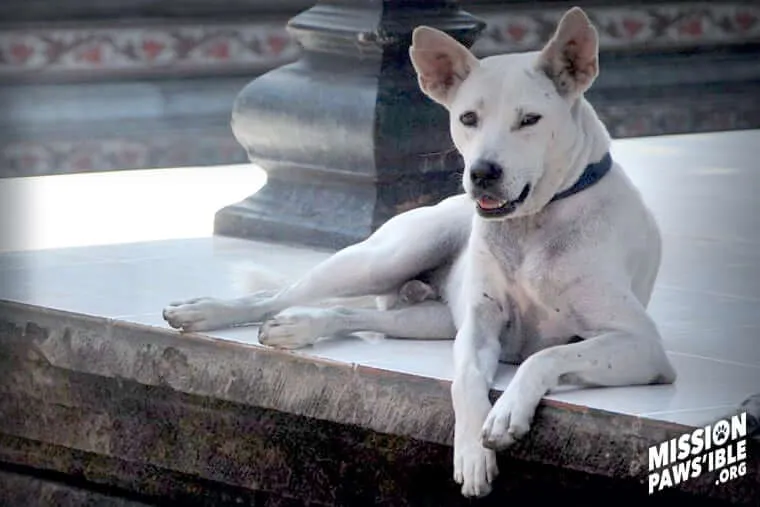The heritage Bali dog
Did you know the ‘Bali dog’ is a breed, not just a dog that lives in Bali?
We are here to give you all the details about how special, sacred, and respected these dogs are to us, and hopefully, you too will understand why we work so hard to protect them.
The Bali Dog has lived and roamed the island of Bali for over 12,000 years. Unbelievable right? Well, it’s true. Their DNA has been traced back 12,000 years. They have lived, roamed and integrated with the people, the villages and the community for centuries, yet today; they are destroyed, neglected and thrown away.
“Studies concluded that the Bali dog is the oldest breed of dog known to man. That means the Bali Dog is older than the Australian Dingo, the New Guinea singing dog, and the African wild dog” BAWA, Bali Animal Welfare Association.
Some people (AKA most people) are opting for western breeds due to marketing and public desire. But here’s the thing, people don’t know enough about the Bali Dog to know WHY they should choose it over the ‘purebreds’.
First and foremost –
the Bali Dog IS THE PUREST BREED IN THE WORLD!
The ‘Spoodley-Poodley-Doodle’ (I made that up, but I am sure it exists) and all the ‘ ‘purebreds’ we know today are mutant creations by humans. If you want to look at the data, you will see inter-breeding to create all shapes, sizes, temperaments, fur types and so on in the name of HUMAN desire, NOT the natural progress of a breed. Just watch the video below to get a better understanding. If you want more details, scroll to the end and watch the other video links we have provided.

The Bali Dog IS pure, untouched, and un-mutanised. The way ‘god’ or whoever created them is the way they are meant to be. Short coats for the humid climate, strong constitution to live and feed off the scraps of the village, natural hunters to feed themselves, territorial to protect their people from intruders and other dogs (they are integral in protecting their village from other dogs entering, such as rabid dogs which is why the vaccination programs are so important, but that’s another discussion altogether).
The Bali Dog is faithful, calm and respectful and has lived in unison with humans forever. They learn from a young age from their parents how to navigate the rice fields, roads and people. They are rarely randomly aggressive. You will often see them asleep in a local warung (restaurants) or on the steps of a temple. Not bothering anyone and not wanting to hurt anything. They are one of the most amazing, beautiful and soulful breeds you will ever have the blessing to meet.
“The Bali dog’s DNA is a mixture of Australian Dingo, Chow-Chow originally from northern China, and Akita, a large Spitz breed of dog originating from the mountainous northern regions of Japan. This inbuilt and hitherto protected genetic diversity makes the Bali dog strong. It can survive on the streets in the harshest of conditions without the veterinary attention needed like western breeds.
The integrity of the Bali dog was protected for centuries until a law prohibiting the import of dogs to Bali was lifted in 2004. Since then, breed dogs have become fashionable. Bali’s heritage dog is now threatened with extinction as a unique breed through a combination of crossbreeding, mass culling and the terrible dog meat trade.
The Balinese people have a very special and cultural relationship with their dogs, even though this is sometimes seen by outsiders as not humane. Balinese society is highly spiritual and can be superstitious. Many people believe the Bali dog will alert people to the unseen presence of “spirits” – both good and bad.” BAWA, Bali Animal Welfare Association
The Bali Dog is indigenous to Bali. Their DNA can be traced back 12,000 years, originating from the Australian Dingo and Asian Wolf.
Temperament: Bali Dogs are intelligent, alert, and friendly, although slightly conservative. They are never overly shy or aggressive. At home, they are an excellent watchdog, sounding a warning bark to announce the arrival of any stranger. They is protective of their home and family, although they do not threaten to bite or attack people. Bali Dogs learn new tasks quickly and are eager to please.
Coat: Short-haired for the tropical climate. Sheds yearly.
Colours: Black, White, Brindle, Mix
Size: Medium
Lifespan: 10 – 15 years
Resources:
Learn About ‘Pedigree’ Dogs:
About the Bali Dog Heritage:
For more information about the DNA studies on Bali dogs, visit http://www.biomedcentral.com/1471-2156/6/6 and also here, Genetic Variation

